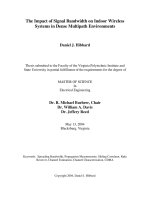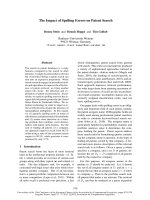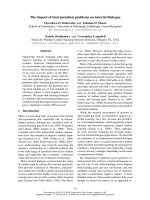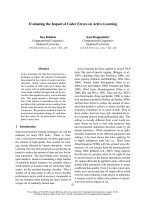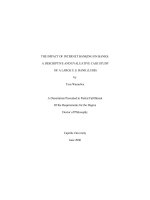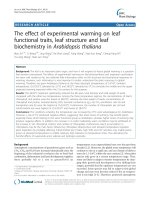Analyzing The Impact Of Flat-Rate Duties On The Cigarette Consumption, Government Budget And Cigarette Smuggling In Asian Countries In 2020.Docx
Bạn đang xem bản rút gọn của tài liệu. Xem và tải ngay bản đầy đủ của tài liệu tại đây (649.37 KB, 42 trang )
NATIONAL ECONOMICS
UNIVERSITY
FACULTY OF ECONOMICS
ERASMUS UNIVERSITY ROTTERDAM
INTERNATIONAL INSTITUTE OF
SOCIAL STUDIES
VIETNAM-NETHERLANDS MASTER’S PROGRAM
IN DEVELOPMENT ECONOMICS (MDE)
THESIS
ANALYZING THE IMPACT OF FLAT-RATE
DUTIES ON THE CIGARETTE CONSUMPTION,
GOVERNMENT BUDGET AND CIGARETTE
SMUGGLING IN ASIAN COUNTRIES IN 2020
Full name
: Le Thi Ngoc Anh
Class
: MDE 26
Major
: Development Economics
Instructor
: Assoc. Professor GIANG THANH LONG
Hanoi 2022
ABSTRACT
This thesis focuses on analyzing the impact of flat-rate duties on the cigarette
consumption, government budget and cigarette smuggling in Asian countries in
2020. We employ three simple linear regression model for the data across Asian
countries. The test results show that flat-rate duties have a negative relationship on
the cigarette consumption and positive relationships with government budget and
cigarette smuggling. As such, we propose that the government of Vietnam can
apply policies to adjust the flat-rate duties and other taxes to minimize the impact of
cigarettes on human development as well as economic development.
TABLE OF CONTENTS
CHAPTER 1: INTRODUCTION..........................................................................................1
1.1 Problem Statement.......................................................................................................1
1.2 Objectives of study.......................................................................................................2
1.3 Research questions.......................................................................................................3
1.4. Scope of the research...................................................................................................3
1.5. Structure of thesis........................................................................................................3
CHAPTER 2: THEORETICAL AND EMPIRICAL BACKGROUND................................5
2.1. Theoretical background...............................................................................................5
2.1.1. Flat-rate duties and cigarette consumption...........................................................5
2.1.2.
Flat-rate duties and government budget...........................................................5
2.1.3.
Flat-rate duties and cigarette smuggling..........................................................7
2.2. Empirical studies.........................................................................................................8
2.2.1. Flat-rate duties and cigarette consumption...........................................................8
2.2.2. Flat-rate duties and government budget...............................................................9
2.2.3. Flat-rate duties and cigarette smuggling............................................................10
CHAPTER 3: RESEARCH METHODOLOGY..................................................................12
3.1. Research approach.....................................................................................................12
3.2. Model establishment.................................................................................................12
3.2.1. Linear approach..................................................................................................12
3.3. Variable description..................................................................................................13
3.2.1.
Dependent variable.........................................................................................13
3.3.2.
Explanatory variables.....................................................................................15
3.4.
Data description.....................................................................................................16
CHAPTER 4: EMPIRICAL RESULTS...............................................................................18
4.1.
Linear regression model........................................................................................18
4.2.
Further problems on the regression model............................................................20
4.2.1.
Ramsey RESET test.......................................................................................20
4.2.2.
Test for heteroskedasticity.............................................................................20
4.2.3.
Test for normality of residuals.......................................................................21
4.3. Hypothesis testing.....................................................................................................23
4.3.1. Hypothesis testing for significance coefficients.................................................23
4.3.2. Test the overall significance of the model.........................................................24
4.4. Discussion.................................................................................................................25
CHAPTER 5: CONCLUSION AND POLICY IMPLICATIONS......................................28
5.1. Conclusion.................................................................................................................28
5.2. Policy implications....................................................................................................29
REFERENCES.....................................................................................................................30
APPENDIX..........................................................................................................................33
LIST OF TABLES
Table 1:Variable description................................................................................................16
Table 2:Data description......................................................................................................16
Table 3: Correlation between variables................................................................................17
Table 4: Regression Results of model (8)............................................................................18
Table 5: Regression results of model (9).............................................................................19
Table 6: Regression results of model (10)...........................................................................19
Table 7: Regression model (8) with robust standard error...................................................22
Table 8: Regression model (9) with robust standard error...................................................23
Table 9: Regression model (10) with robust standard error.................................................23
CHAPTER 1: INTRODUCTION
1.1 Problem Statement
According to the World Health Organization (2019), around 7.1 million
people die from cigarettes worldwide annually, and among them, 900,000 people
died from cigarettes smoke. Cigarettes with thousands of toxins have caused about
25 different diseases such as cancer, cardiovascular disease, respiratory disease, as
well as affected reproductive health. According to the World Cancer Research Fund
(2020), 85% of lung cancer cases are caused by smoking and smelling cigarettes
smoke. Smoking is not only harmful to the health of smokers and those around
them, but also causes great losses to the economy and society. To produce
cigarettes, farmers have to spend a part of their production land to grow cigarettes
ingredients. Cigarette smoking also pollutes the air, and the smoke released into the
environment makes people around you sick by inhaling second-hand smokers.
Cigarettes waste also adversely affects the living environment. Cigarettes is the
leading cause of environmental pollution and long-term consequences. Therefore,
cigarette is the cause of increasing costs of environmental protection services,
overcoming air pollution and living environment. According to the World Health
Organization (2020), cigarettes usage is also one of the causes of poverty, affecting
the country’s sustainable development.
In Vietnam, as stated in Ministry of Health’s annual report in 2020, annually,
about 40,000 people die from cigarette-related diseases and 33 million non-smokers
are affected by cigarettes smoke. Although the rates of smoking and secondhand
smoking in Vietnam have decreased, the number of cigarette users in Vietnam is
still in the list of top 15 countries with the number of cigarette users in the world.
This report also stated that the rate of illness and premature death due to cigarettes
use accounted for 12% of the total disease burden. Moreover, cigarettes use is also
one of the causes of poverty, affecting the country’s sustainable development. The
report shows that currently in Vietnam, the total cost of treatment and loss of work
capacity due to illness and premature death due to cigarettes causes 5 groups of
diseases (i.e., lung cancer, upper respiratory cancer, lung disease, myocardial
infarction, stroke) is more than 23,000 billion VND per annum. Meanwhile, the
survey conducted by Institute of Medical Genetics of Vietnam (2020) shows that
each year more than 30,000 billion VND were “burned” to buy cigarettes.
Recently, cigarette is a product to limit consumption because it causes a great
harm to human health. In the world today, many Asian countries levy excise flatrate duties on cigarette with a particularly high flat-rate duties rate in order to
control consumption of this harmful product. Nguyen (2018) stated that income per
person in Vietnam is increasing faster than that of cigarette prices so cigarettes are
getting more affordable. Low cigarette prices are believed to lead to a high
percentage of smokers in Vietnam, and as such Vietnam is in the process of
considering the form of increasing the excise flat-rate duties on cigarettes.
Given the above situation, this thesis, namely “Analyzing the impact of flatrate duties on the cigarette consumption, government budget and cigarette
smuggling in Asian countries in 2020”, was conducted. From observing the
relationship between changes in flat-rate duties among Asian countries, the author
would like to point out the impact of flat-rate duties on the cigarette consumption,
government budget and cigarette smuggling in these countries. In addition, the
thesis recommends the solutions for Vietnam government to cut down on the
number of smokers and overcome remained consequences.
1.2 Objectives of study
The general objective of the thesis is to determine the impact of flat-rate
duties on the cigarette consumption, government budget and cigarette smuggling in
Asian countries in 2020, and then propose the solutions for Vietnam government to
cut down on the number of smokers and overcomes remained consequences.
The specific objectives include:
i.
Figure out the impact of flat-rate duties on the cigarette consumption,
government budget and cigarette smuggling in Asian countries.
ii. Recommend the solutions for the Government of Vietnam to decrease the
number of smokers and overcome remained consequences.
1.3 Research questions
To obtain these two aforementioned specific research objectives, this thesis
focuses on answering the following questions:
1) What is the impact of flat-rate duties on the cigarette consumption,
government budget and cigarette smuggling in Asian countries?
2) What is the impact of flat-rate duties on government budget in Asian
countries?
3) What is the impact of flat-rate duties on the cigarette smuggling in Asian
countries?
1.4. Scope of the research
The research is focus on analyzing the impact of flat-rate duties on the
cigarette consumption, government budget and cigarette smuggling in Asian
countries. According to WHO (2021), Some other countries in Asia, such as the
Philippines, Cambodia, Laos, Malaysia and Thailand, have alarmingly high male
smoking rates of over 40%. In Asian countries, more than 7 million people die each
year from tobacco-related diseases, of which 600,000 die from passive exposure to
tobacco smoke. Seven million deaths are a huge amount, but that number continues
to rise. Every tobacco death is a preventable tragedy. Those deaths, and the
suffering caused by tobacco-related diseases, have far-reaching effects on the health
of individuals and their families, on the well-being of communities, and on the
development of Countries. Efforts to promote ratification of the World Health
Organization Framework Convention on Tobacco Control are facing obstacles in
Southeast Asia. It is one of the regions with the highest number of smokers in the
world, one of the reason is that in Asian countries, cigarette smuggling happens
frequently. Hence, the data sets are cross-sectional, which were collected in 2020
for 48 Asian countries.
1.5. Structure of thesis
The research consists of five chapters as followings:
Chapter 1 explains reason the topic of thesis is chosen, significance of the
thesis, main objectives, some major research questions and the scope of the
research.
Chapter 2 provides an overview on theoretical background of the impact of
flat-rate duties on the cigarette consumption, government budget and cigarette
smuggling.
Chapter 3 highlights the research methodology. This chapter also describes
the general econometrics model, variables and data and outlines the way to analyze
data.
Chapter 4 shows the statistical results from adopted models. Findings are
analyzed and to make clear in reaching objectives and answering the questions in
Chapter 1. Results of empirical studies by other researchers are also used to strongly
support our findings.
Chapter 5 resumes main findings and recommends useful policies for Vietnam
in strategy of decreasing the number of smokers and overcoming remained
consequences. This chapter also identifies the limitation and implications for further
study.
CHAPTER 2: THEORETICAL AND EMPIRICAL BACKGROUND
Chapter 1.
2.1. Theoretical background
2.1.1. Flat-rate duties and cigarette consumption
Theoretically, the relationship between flat-rate duties and cigarette
consumption is expressed according to demand curve: when the price of X increase
since the government impose tax, the supply curve shifts left, hence, the consumer
buy X less and reduce their consumption (Mankiw, 1997). In the relationship
between flat-rate duties and cigarette consumption, when government increase flatrate duties on cigarettes, the price of cigarette goes up, then the demand buying
cigarette decrease relatively, hence, reduce the consumption of cigarettes. The
relationship can be explained by Figure 1.
Figure 1. Taxes and consumption
P
S2
S1
E2
P2
Taxes
E1
P1
D
Q2
Q1
Q
Source: Mankiw (1997)
Chapter 1.
2.1.2. Flat-rate duties and government budget
Vietnam’s flat-rate duties rate in the retail price of cigarettes is low, for a
dollar a pack of cigarettes, the government earns only 35 cents, the tobacco industry
brings in 65 cents (WHO, 2018). Visaruthvong (2012) commented that the
proportion difference is so huge that the government does not get anything. An
increase in flat-rate duties is considered effective must ensure that retail prices
increase and consumption decreases.
The consumer behavior of buying cigarette can be explained by Price
Elasticity of Demand. According to Thomas (2015), it measures sensitivity of
demand to price. Thus, it measures the percentage change in demand in response to
a change in price. More precisely, it gives the percentage change in quantity
demanded in response to a one per cent change in price (ceteris paribus, i.e. holding
constant all the other determinants of demand, such as income). Expressing this
mathematically, price elasticity of demand is calculated by dividing the percentage
change in the quantity demanded by the percentage change in the price. If price
elasticity of demand is calculated to be less than 1, the good is said to be inelastic.
An inelastic good will respond less than proportionally to a change in price; for
example, a price increase of 40% that results in a decrease in demand of 10%.
Goods that are inelastic often have at least one of the following characteristics:
-
Few, if any, available substitutes (e.g. precious metals)
-
Essential goods (e.g. petrol)
-
Addictive goods (e.g. alcohol, cigarettes)
-
Bought infrequently or a small percentage of income (e.g. salt)
For goods with a high elasticity value, consumers will be more sensitive to
price changes. For the average consumer, an increase in price of an inessential good
with many available substitutes will often result in that consumer not purchasing the
good at all, or purchasing one of the substitutes instead (Layton et al., 2016).
The cost to produce a pack of cigarettes is very cheap. When buying a pack of
cigarettes for a dollar, the production cost is about 20-25 cents. According to WHO
(2018), tobacco is also a product with very low elasticity of demand and is
addictive, so even if the price increases a lot, the reduction in consumption will be
very small compared to other products. Therefore, increased price and smaller
decreases in quantity make the government budget collected form cigarette increase.
2.1.3. Flat-rate duties and cigarette smuggling
Cigarette flat-rate duties are a popular way for governments to raise revenue
and attempt to thwart the purported sin of smoking. The excise of flat-rate duties is
imposed on packs of cigarettes by different countries, and thus, price is different
across nations. According to St. John and Gabrielle (2021), higher price usually
leads to higher probability of avoiding taxes by smuggling due to these five below
reasons.
Firstly, the higher the flat-rate duties rate, the more it creates a conception of
avoiding declaring tax at disposable income or the quantity of good imported. This
creates transfer pricing practices by multinationals in order to pay flat-rate duties in
countries with lower flat-rate duties rates, or to hide revenues, incomes, or vice
versa. People can import units which are declared to be at imported prices lower
than transaction prices to pay low import flat-rate duties, excise flat-rate duties and
value added flat-rate duties, which causes smuggling.
Second, although continuously improved, amended and supplemented, the
taxation laws still have loopholes that flat-rate duties payers can target to commit
flat-rate duties frauds. The most performed behavior is buying and selling invoices
to legalize transactions; setting up ghost business to sell bills then run away.
Third, lack of awareness of people and businesses in the implementation of
tax obligations. The level of tax awareness of the population is still low, especially
in understanding the provisions and contents of flat-rate duties laws. This leads to
the situation of abetting with intentional acts of businesses in buying and selling
cigarette, using invoices for profit.
Fourth, limitations in flat-rate duties administration by authorities and other
law enforcement teams has remained. Flat-rate duties officials are not fully
equipped with measures to prevent and combat flat-rate duties evasion, especially is
a team of inspectors and examiners. A part of flat-rate duties officials and
employees still exploits, and compromises with flat-rate duties payers ignore
fraudulent acts. There is no good coordination mechanism between flat-rate duties
authorities and police and state audit agencies. The limitations lead to the cigarette
smuggling between countries.
Fifth, the existence of cash transactions, plus the proliferation of services such as
Airbnb accommodation service or Grab transportation service; e-commerce sites
with many business accounts such as Lazada, Tiki, Shopee; online advertising
services of Google, Yahoo, YouTube... create many risks of flat-rate duties evasion.
Transactions may not be recorded or deleted after execution. Revenues from online
selling through these applications or online sales are also not declared or declared
incorrectly, transaction data may be modified or deleted after implementation. Thus,
people can easily buy and sell illegal cigarettes.
2.2. Empirical studies
2.2.1. Flat-rate duties and cigarette consumption
Mentioning the relationship between flat-rate duties and cigarette
consumption, Morris (2002) stated that of all the concerns, there is one-flat-rate
taxation - that alarms us the most. While marketing restrictions and public and
passive smoking restrictions do depress volume, in our experience flat-rate taxation
depresses it much more severely. Our concern for flat-rate taxation is, therefore,
central to our thinking. When the flat-rate duties go up, industry loses volume and
profits as many smokers cut back. Besides, Reynolds (2005) investigated that if
prices were 10% higher, 12-17 incidence or youth smoking would be 11.9% lower
or more on cigarette company documents and flat-rate duties increases, Barnum
(1994) showed us that the cigarette companies have even publicly admitted the
effectiveness of flat-rate duties increases to deter smoking in their required filings
with the U.S. Securities and Exchange Commission. Economic research confirms
that cigarette flat-rate duties increases reduce smoking. The general consensus is
that nationally, every 10 percent increase in the real price of cigarettes reduces adult
smoking by about two percent, reduces smoking among young adults by about 3.5
percent, reduces the number of kids who smoke by six or seven percent, and
reduces overall cigarette consumption by approximately three to five percent.
Moreover, Drope (2018) showed that in the U.S, although there are many
other factors involved, the trends in cigarette prices and overall U.S. cigarette
consumption from 1970 to 2017 show that there is a strong correlation between
increasing prices by increasing flat-rate duties and decreasing consumption. While
U.S. cigarette prices are largely controlled by the tobacco companies’ price-setting
decisions, increases in federal and state cigarette flat-rate duties also impact prices.
Since 1970, the federal flat-rate duties on cigarettes increased from eight cents to
$1.01 per pack, with the largest one-time increase of 61.66 cents per pack occurring
in 2009. Meanwhile, the average state cigarette flat-rate duties have increased from
10 cents to $1.91 per pack today. Without these federal and state flat-rate duties
increases, U.S. cigarette prices would be much lower and U.S. smoking levels
would be much higher.
In contrast, other research of Huang & Chaloupka (2018) have also found
that cigarette price and flat-rate duties increases work even more effectively to
reduce smoking among Blacks, Hispanics, and lower-income smokers. Moreover, a
cigarette flat-rate duties increase that raises prices by ten percent will reduce
smoking among pregnant women by seven percent, preventing thousands of
spontaneous abortions and still-born births, and saving tens of thousands of
newborns from suffering from smoking-affected births and related health
consequences. The last is that higher flat-rate duties on smokeless tobacco reduce its
use, particularly among young males; and increasing cigar prices through flat-rate
duties increases reduce adult and youth cigar smoking.
2.2.2. Flat-rate duties and government budget
World Bank (2012) estimates that a 10% increase in flat-rate duties globally
will increase government cigarette flat-rate duties revenues by 7%. Besides,
according to the World Health Organization (2020), the governments of several
countries around the world could collect an additional $141 billion from tobacco
flat-rate duties if the flat-rate duties increases were to average $0.8 per pack.
Particularly in some countries where the flat-rate duties density in retail prices is
low, as in Vietnam, an increase in cigarette flat-rate duties usually does not lead to a
large increase in the distribution price of cigarettes or a sharp decrease in
consumption. Hence, it will increase the revenue from cigarette flat-rate duties at a
very significant level for the country.
World Health Organization (2020) point out that, in South Africa, in the
period 1991-2012, cigarette flat-rate duties, after deducting inflation, increased from
2 Rands to 10 Rands per pack. As a result, cigarette flat-rate duties revenue has
increased from 3 billion Rands to nearly 12 billion Rands in the community.
In Thailand, from 1993 to 2012, cigarette flat-rate duties increased from 55%
to 87% of the wholesale distribution price. As a result, budget revenue quadrupled,
from USD 500 million in 1993 to USD 2.0 billion in 2015.
In 2012 the Philippines passed a flat-rate duties law, increasing the cigarette
flat-rate duties with several different classes of tobacco to reach a common flat-rate
duties rate in 2017. As a result, the government’s cigarette flat-rate duties collection
has increased more than doubled immediately, from $680 million in 2012 to $1.6
billion in 2013. This number increased to $2.2 billion in 2015, more than three
times the pre-flat-rate duties increase.
In Turkey, in 2010 this country increased flat-rate duties significantly,
causing the flat-rate duties in the retail price to increase from 58% to 63% and the
absolute flat-rate duties floor (in packs of 20 cigarettes) also increased from 1.55 TL
to 2.65 TL. This flat-rate duties increase causes the price of cigarettes to fluctuate
more than double. As a result, the Government’s cigarette flat-rate duties revenue
increased by more than 40%, from TL 11 billion in 2009 to TL 15.9 billion in 2011.
Especially in Brazil, from 2006 to 2013, the flat-rate duties per pack
increased significantly, the average real cigarette price increased by 74%. As a
result, government flat-rate duties revenue from tobacco increased by 48%, from
3.5 billion reais in 2006 to 5.1 billion reais in 2013, although domestic tobacco
distribution sales fell by 32%, from 6 56 billion bags in 2013 to 3.8 billion bags in
2016.
2.2.3. Flat-rate duties and cigarette smuggling
Real-life situations proved in the opposite statements to the theory mentioned
above. Phan (2020) said that we should not have the mindset of “if you can’t
manage it, you can’t ban it”, especially in the context of Vietnam, which is keeping
up with the technological development trends. International experiences show that
increasing flat-rate duties on tobacco products not only helps increase budget
revenue, reduce the number of smokers, thereby reducing diseases, but also does not
cause tobacco smuggling. Nguyen et al. (2020) stated that the absence of a
correlation between tax changes and smuggling suggested that potential increases in
the excise tax should not be discouraged by the threat of an increase in illicit trade.
On the other hand, Vietnam’s low prices on domestic cigarettes provided easy
access to illicit cigarettes for the Vietnamese people. To effectively reduce the
prevalence of illicit cigarettes in Vietnam, the government should increase cigarette
taxes to raise domestic cigarette prices and implement strong policy measures to
create a more transparent social environment. For example, Lecours et. al (2012)
showed that in France, when the price of cigarettes tripled, tobacco consumption
fell by one third and tax revenue doubled. In Thailand and the Philippines,
increasing tobacco flat-rate tax over the years reduces consumption of this product,
but increases budget revenue and does not cause an increase in cigarette smuggling.
Lam (2020) said that excise tax is not an important factor related to cigarette
smuggling. The smuggling situation is due to very high import tax barriers,
currently 135% of the import price. After that, special consumption tax and valueadded tax are added.
Supported Lam’s research (2020), Le (2020) argued that there has been no
strong link between tax increases and increased smuggling. Many countries have
high taxes but low smuggling and vice versa. Vietnam’s cigarette smuggling
increases even if tobacco taxes do not increase.
CHAPTER 3: RESEARCH METHODOLOGY
3.1. Research approach
The research procedure and data are introduced in this chapter in order to
answer the questions mentioned in chapters 1. The links between variables (flat-rate
duties, cigarette consumption, government budget and cigarette smuggling) are
investigated, using linear regression model and ordinary least squares (OLS)
estimation method.
Simple linear regression model:
Simple linear regression analysis is a method of analyzing the relationship
between one dependent variable Y and an independent variable X. Modeling uses a
linear function. The functions are estimated from the collected data.
Y= β0 + β1X + ui
(1)
β 0 is the intercept of the population regression model; β i is the slope coefficient
^ is the estimators of β i; µt is
of the independent variables which corresponds to it; ❑
i
^ t is the residual
the disturbance; and µ
OLS estimation method:
The method of least squares, also known as least squares or mean squares, is
an optimization method for selecting a best fit line for a data range that corresponds
to the extremes of the sum of the error between the fit line and the data.
3.2. Model establishment
This paper will be focus on the relationship between flat-rate duties, cigarette
consumption, government budget and cigarette smuggling among Asian countries in
2020.
3.2.1. Linear approach
This paper uses three simple linear regression model in order to investigate the
relationship between flat-rate duties, cigarette consumption, government budget and
cigarette smuggling among Asian countries. The equation is log-log function,
depicted as following:
Population regression models:
lnCON i=❑01 +❑11 lnFLi +µ i
(2)
lnGOV i=❑02 +❑12 lnFLi + µi
(3)
lnSMUG=❑03+❑13 lnFLi + µi
(4)
Sample regression model:
^ +❑
^ lnFL +µ
lnCON i=❑
01
11
i
i
(5)
^ +❑
^ lnFL + µ
lnGOV i=❑
02
12
i
i
(6)
^ +❑
^ lnFL + µ
lnSMUG=❑
03
13
i
i
(7)
Where:
β 0 is the intercept of the population regression model; β i is the slope coefficient
^ is the estimators of β i; µt is
of the independent variables which corresponds to it; ❑
i
the disturbance; and ^µt is the residual
Equations (2) – (4) shows that flat-rate duties variable (FL) has the impact on
cigarette consumption variable (CON), government budget variable (GOV) and
cigarette smuggling variable (SMUG). From this model, this thesis is interested in
explaining three dependent variables in term of one independent variable and prove
the relationship between them in the logarithm is linear.
3.3. Variable description
The data consists of observations of all Asian countries’ flat-rate duties (FL) in
2020 has the relationship with cigarette consumption variable (CON), government
budget variable (GOV) and cigarette smuggling variable (SMUG). The data of all
Asian countries’ flat-rate duties chosen for running model is taken from World
Bank (). The cigarette consumption data, government
budget from taxes and cigarette smuggling variable is displayed on WHO annual
report
on
cigarette
prevention
( />Chapter 1.
3.2.1. Dependent variable
Cigarette consumption
The term “cigarette”, commonly used to refer to a cigarette and other objects
containing aromatic leaves. Because of the scientific evidence that in the specific
case life expectancy is shortened when the risk of lung cancer increases, tobacco
products shorten life, many countries have printed health warnings in large font in
the United States. the front and back of each pack of cigarettes to warn about the
harmful effects of smoking, and to ban all advertising to sell cigarettes... In addition
to regular cigarettes, there are other variations such as smokeless cigarettes,
electronic cigarettes, and tobacco (agricultural products).
Smoking is the most common method of cigarettes consumption and cigarettes
is the most common substance smoked. Agricultural products are often mixed with
additives and then burned. The smoke is then inhaled and the active ingredients are
absorbed through the alveoli in the lungs or the lining of the mouth. Traditionally,
combustion is enhanced by the addition of potassium or nitrates. Many substances
in cigarette smoke trigger chemical reactions at nerve endings, increasing heart rate,
alertness, and reaction time, among other things. Dopamine and endorphins are
released, often associated with smoking pleasure. Between 2008 and 2010,
cigarettes were used by approximately 49% of men and 11% of women aged 15
years and older in 14 low- and middle-income countries (Bangladesh, Brazil, China,
Egypt, India, Mexico, Philippines, Poland, Russia, Thailand, Turkey, Ukraine,
Uruguay and Vietnam) with about 80% smoking as the most common way of
consumption. The gender gap tends to be less pronounced in the lower age groups.
Government budget from cigarette tax
State budget, government budget, or national budget is an economic and
historical category; part of the financial system. The term “State budget” is widely
used in economic and social life in all countries. However, the concept of state
budget is not uniform, people have given many definitions of state budget according
to schools and research fields. Russian economists believe that the state budget is a
list of revenues and expenditures in money in a given period of the country. The
formation and development of the state budget is associated with the emergence and
development of commodity-monetary economy in the production methods of the
community and the state of each community. In other words, the birth of the state
and the existence of a commodity-monetary economy are the premise for the
arising, existence and development of the state budget.
The government budget from cigarette tax is the amount of money the
government collected from the tobacco consumed, produced and imported in the
market. It is calculated by taking tax rate multiple the number of cigarette in the
market in a period of time, normally within one year.
Cigarette smuggling
Smuggling is the behavior of illegal cross-border trade in goods. Smuggling is
a dangerous act for society and infringes upon the State’s foreign trade management
regime. Therefore, the criminal law of Vietnam has considered the act of smuggling
to a certain extent a crime.
Smuggled tobacco products are products made from all or part of tobacco
ingredients and processed in the form of cigarettes, cigars, tobacco used for
smoking pipes and other forms of products used for smoking, chewing, smelling
originating from abroad, not having enough invoices and vouchers.
Chapter 1.
3.3.2. Explanatory variables
Flat-rate duty is a flat-rate duties introduced to avoid commercial fraud on
import prices because no matter how much the invoice is, paying flat-rate duties is
considered to have been avoided by the state. It is a flat-rate duties rate is fixed by a
fixed number per unit of the flat-rate taxable object. The flat-rate duties calculation
method is the fixation of a certain flat-rate duties amount on a unit of imported or
exported goods. Pursuant to Article 6 of the 2016 Import and Export Flat-rate duties
Law stipulates:
“The flat-rate duties amount applying the flat-rate duties calculation method
to exported and imported goods is determined based on the actual quantity of
exported or imported goods and the flat-rate duties prescribed for a unit of goods
in a specific point of time.”

